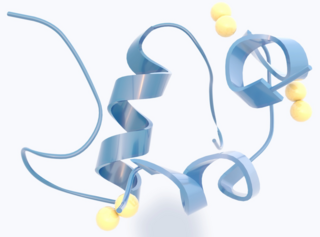Related Research Articles

Hypoglycemia, also called low blood sugar, is a fall in blood sugar to levels below normal, typically below 70 mg/dL (3.9 mmol/L). Whipple's triad is used to properly identify hypoglycemic episodes. It is defined as blood glucose below 70 mg/dL (3.9 mmol/L), symptoms associated with hypoglycemia, and resolution of symptoms when blood sugar returns to normal. Hypoglycemia may result in headache, tiredness, clumsiness, trouble talking, confusion, fast heart rate, sweating, shakiness, nervousness, hunger, loss of consciousness, seizures, or death. Symptoms typically come on quickly.
Idiopathic hypoglycemia is a medical condition in which the glucose level in the blood is abnormally low due to an undeterminable cause. This is considered an incomplete and unsatisfactory diagnosis by physicians and is rarely used by endocrinologists, as it implies an unfinished diagnostic evaluation. In general, the more severe the hypoglycemia and the more clearly it is proven, the less likely it is to remain "idiopathic". Idiopathic hypoglycemia can also be a synonym for reactive hypoglycemia or for hypoglycemia that is not diagnosed by a physician and does not fulfill the Whipple triad criteria. A more precise term for that condition is idiopathic postprandial syndrome.

An insulinoma is a tumour of the pancreas that is derived from beta cells and secretes insulin. It is a rare form of a neuroendocrine tumour. Most insulinomas are benign in that they grow exclusively at their origin within the pancreas, but a minority metastasize. Insulinomas are one of the functional pancreatic neuroendocrine tumour (PNET) group. In the Medical Subject Headings classification, insulinoma is the only subtype of "islet cell adenoma".
Hyperinsulinemic hypoglycemia describes the condition and effects of low blood glucose caused by excessive insulin. Hypoglycemia due to excess insulin is the most common type of serious hypoglycemia. It can be due to endogenous or injected insulin.

Hyperinsulinism refers to an above normal level of insulin in the blood of a person or animal. Normal insulin secretion and blood levels are closely related to the level of glucose in the blood, so that a given level of insulin can be normal for one blood glucose level but low or high for another. Hyperinsulinism can be associated with several types of medical problems, which can be roughly divided into two broad and largely non-overlapping categories: those tending toward reduced sensitivity to insulin and high blood glucose levels (hyperglycemia), and those tending toward excessive insulin secretion and low glucose levels (hypoglycemia).

A pancreaticoduodenectomy, also known as a Whipple procedure, is a major surgical operation most often performed to remove cancerous tumours from the head of the pancreas. It is also used for the treatment of pancreatic or duodenal trauma, or chronic pancreatitis. Due to the shared blood supply of organs in the proximal gastrointestinal system, surgical removal of the head of the pancreas also necessitates removal of the duodenum, proximal jejunum, gallbladder, and, occasionally, part of the stomach.
Allen Oldfather Whipple was an American surgeon who is known for the pancreatic cancer operation which bears his name as well as Whipple's triad.

Congenital hyperinsulinism (HI or CHI) is a rare condition causing severe hypoglycemia in newborns due to the overproduction of insulin. There are various causes of HI, some of which are known to be the result of a genetic mutation. Sometimes HI occurs on its own (isolated) and more rarely associated with other medical conditions.

Hyperinsulinemia is a condition in which there are excess levels of insulin circulating in the blood relative to the level of glucose. While it is often mistaken for diabetes or hyperglycaemia, hyperinsulinemia can result from a variety of metabolic diseases and conditions, as well as non-nutritive sugars in the diet. While hyperinsulinemia is often seen in people with early stage type 2 diabetes mellitus, it is not the cause of the condition and is only one symptom of the disease. Type 1 diabetes only occurs when pancreatic beta-cell function is impaired. Hyperinsulinemia can be seen in a variety of conditions including diabetes mellitus type 2, in neonates and in drug-induced hyperinsulinemia. It can also occur in congenital hyperinsulinism, including nesidioblastosis.

Reactive hypoglycemia, postprandial hypoglycemia, or sugar crash is a term describing recurrent episodes of symptomatic hypoglycemia occurring within four hours after a high carbohydrate meal in people with and without diabetes. The term is not necessarily a diagnosis since it requires an evaluation to determine the cause of the hypoglycemia.

Multiple endocrine neoplasia type 1 (MEN-1) is one of a group of disorders, the multiple endocrine neoplasias, that affect the endocrine system through development of neoplastic lesions in pituitary, parathyroid gland and pancreas. Individuals suffering from this disorder are prone to developing multiple endocrine and nonendocrine tumors. It was first described by Paul Wermer in 1954.

GLUD1 is a mitochondrial matrix enzyme, one of the family of glutamate dehydrogenases that are ubiquitous in life, with a key role in nitrogen and glutamate (Glu) metabolism and energy homeostasis. This dehydrogenase is expressed at high levels in liver, brain, pancreas and kidney, but not in muscle. In the pancreatic cells, GLUD1 is thought to be involved in insulin secretion mechanisms. In nervous tissue, where glutamate is present in concentrations higher than in the other tissues, GLUD1 appears to function in both the synthesis and the catabolism of glutamate and perhaps in ammonia detoxification.
An insulin tolerance test (ITT) is a medical diagnostic procedure during which insulin is injected into a patient's vein, after which blood glucose is measured at regular intervals. This procedure is performed to assess pituitary function, adrenal function, insulin sensitivity, and sometimes for other purposes. An ITT is usually ordered and interpreted by an endocrinologist.
Seale Harris was an American physician and researcher born in Cedartown, Georgia. He was nicknamed "the Benjamin Franklin of Medicine" by contemporaries for his leadership and writing on a wide range of medical and political topics. Dr. Harris' most celebrated accomplishments were his 1924 hypothesis of hyperinsulinism as a cause of spontaneous hypoglycemia.
Neonatal hypoglycemia occurs when the neonate's blood glucose level is less than the newborn's body requirements for factors such as cellular energy and metabolism. There is inconsistency internationally for diagnostic thresholds. In the US, hypoglycemia is when the blood glucose level is below 30 mg/dL within the first 24 hours of life and below 45 mg/dL thereafter. In the UK, however, lower and more variable thresholds are used. The neonate's gestational age, birth weight, metabolic needs, and wellness state of the newborn has a substantial impact on the neonates blood glucose level. There are known risk factors that can be both maternal and neonatal. This is a treatable condition. Its treatment depends on the cause of the hypoglycemia. Though it is treatable, it can be fatal if gone undetected. Hypoglycemia is the most common metabolic problem in newborns.
In medicine, a nesidioblastoma is an uncommon, insulin-secreting, pancreatic neuroendocrine tumor (PanNET). The term dates to at least 1938. In that report, these lesions were adjudicated as histologically benign adenoma growths, that were associated with severe, long-standing hypoglycemia due to hyperinsulinism. Surgical removal corrected the low glucose problems. There is no rigorous definitional separation from insulinoma, other than the original emphasis that was placed on the observed precise histological recapitulation of normal islet cell structure within the adenomas, which lacked microscopic features of aggressivity.
Glucose-elevating agents are medications used to treat hypoglycemia by raising blood glucose. In diabetics, hypoglycemia can occur as a result of too much insulin or antidiabetic medication, insufficient food intake, or sudden increase in physical activity or exercise. The most common glucose-elevating agents used to treat diabetic hypoglycemia are glucose and glucagon injections when severe hypoglycemia occurs. Diazoxide, which is used to counter hypoglycemia in disease states such as insulinoma or congenital hyperinsulinism, increases blood glucose and decreases insulin secretion and glucagon accelerates breakdown of glycogen in the liver (glycogenolysis) to release glucose into the bloodstream.
A metastatic insulinoma is a rare form of a malignant insulinoma involving metastatic growth. An insulinoma is a small tumor localized to the pancreas, originating from islet beta cells, which produce an excess of insulin. The increase in insulin ultimately leads to hypoglycemia. Insulinomas are commonly benign tumors, but can metastasize and become malignant. The metastatic growth can be characterized as a local invasion or distal metastasis. However, insulinomas are often difficult to detect due to their relatively small size, with a diameter oftentimes less than 2 cm. Therefore, clinical appearance and pathology are not sufficient in diagnosing a malignant insulinoma. Malignant insulinomas are not easily treated, as they require various treatments dependent on each person's case.
Dasiglucagon, sold under the brand name Zegalogue, is a medication used to treat severe hypoglycemia in people with diabetes.
References
- 1 2 3 Melmed, Shlomo (2016). Williams textbook of endocrinology (13 ed.). Elsevier. pp. 1582–1607. ISBN 978-0-323-29738-7.
- 1 2 3 4 5 Martens, Pieter; Tits, Jos (2014-06-01). "Approach to the patient with spontaneous hypoglycemia". European Journal of Internal Medicine. 25 (5): 415–421. doi:10.1016/j.ejim.2014.02.011. ISSN 0953-6205. PMID 24641805 – via ScienceDirect.
- ↑ Desimone, Marisa E.; Weinstock, Ruth S. (2000), Feingold, Kenneth R.; Anawalt, Bradley; Blackman, Marc R.; Boyce, Alison (eds.), "Hypoglycemia", Endotext, South Dartmouth (MA): MDText.com, Inc., PMID 25905360 , retrieved 2023-10-27
- ↑ Cazabat, L.; Chanson, P. (2009-09-01). "Hypoglycémie et insulinome". Annales d'Endocrinologie. 70: S2–S11. doi:10.1016/S0003-4266(09)72470-9. ISSN 0003-4266. PMID 19878764 – via ScienceDirect.
- ↑ Whipple, Allen O (1938). "The surgical therapy of hyperinsulinism". International Journal of Surgery . 3: 237–276 – via Scopus.